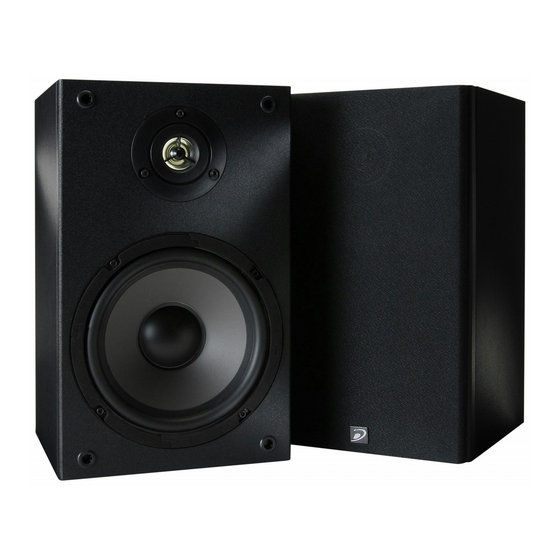DaytonAudio B652 Посібник користувача - Сторінка 3
Переглянути онлайн або завантажити pdf Посібник користувача для Спікери DaytonAudio B652. DaytonAudio B652 4 сторінки. 6-1/2" 2-way bookshelf speaker pair
Також для DaytonAudio B652: Посібник користувача (2 сторінок), Посібник користувача (2 сторінок)

Start with the speakers directly in front of your primary listening position. Avoid
hard vertical edges within 3 or 4 feet of either side of the cabinet. Position the
cabinets about 1-2 feet out from the wall. Listen to one of the selected recordings
paying close attention to the positions of the instruments and vocalist. Move the
speakers a few inches at a time, returning to the listening position to evaluate the
results. Once placement is optimized, the vocalist will be firmly positioned in front
of the instruments and the instruments will seem to be between or behind the
loudspeakers. During the design of most Dayton Audio speakers, performance is
optimized for listener location 10-12 feet in front of the tweeter. If possible, position
your speakers so that when you are seated in the primary listening position your
ears are 10-12 feet from the tweeter. Viewed from your seat, the angle between
the speakers should be 30 to 60 degrees. Pay special attention to the bass. The
relation between bass response and room position is critical. Tightly localized high
and low pressure spots result from reflections off the room boundaries. Moving
one or both of the loudspeakers just a few inches will rearrange thousands of hot
and dead spots all over the room. The secret to proper positioning is to keep the
worst of these spots from falling on the primary listening position. Position the
speakers so that the bass levels are in proper perspective to the rest of the musical
spectrum. Listen to several recordings so that you hear bass from a variety of
instruments. The most common positioning error involves getting the bass level
right for one note, but not for others.
Loudspeaker positioning can be time consuming, but the rewards justify the effort.
CABINET CARE
The finish of your speakers can be maintained and enhanced by periodic use
of a surface protection such as "ArmorAll". The grills may be vacuumed or gently
tapped or brushed to remove dust and debris.
POWER RATINGS
Almost any speaker can be used successfully with almost any amplifier.
Conversely, almost any speaker can be damaged by almost any amplifier,
despite either unit's power rating. The power recommendations that we publish
are accurate only if our assumptions concerning the amplifier, the type of music,
and the conditions of use are correct. Most importantly we assume that the
volume never is set above the point of distortion. Distortion is an indication that
the amplifier or loudspeaker is operating beyond its design limits. If you hear
distortion, immediately reduce the volume. Damage can occur within seconds.
Do not ignore distortion just because the volume control is not all the way up. A
common misconception exists that amplifier power is proportional to the setting of
the volume control with maximum setting necessary for full power output. This is
rarely the case. Most amplifiers deliver full power when the volume control is set
somewhere in the middle of its range. Use of loudness, bass boost, treble boost,
or an equalizer can produce full output at even lower knob settings. Distortion is
the only clue that damage is imminent.
Dayton Audio loudspeakers are designed to reproduce music and speech in
a home environment at moderate volume levels. When used within their limits
Dayton Audio loudspeakers will provide many years of trouble free performance.
